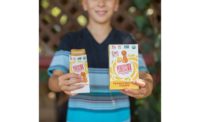![]()
Kids
A candy purchase is often the first one a child makes,
so make sure it’s a good and memorable one!
It’s hard to find a
kid today who doesn’t like candy. Candy is often tops on a
kid’s purchase list—collective kid candy purchases even beat
out collective kid toy purchases, according to a 2003 study by the Wonder
Group, a marketing company that specializes in targeting kids. What’s
more, a candy purchase is often the first independent purchase a child will
make.
Candy marketers typically know this, but often they
don’t bother really getting to know this youngest consumer group.
Grouped with the teens and tweens who are just a few years ahead of them,
today’s kids are members of the Millennial Generation, a generation
nearly as large as the baby boom and filled with as much potential,
according to experts. This youthful group of kids aged 16 and under
is predicted to have good growth until 2010, at which point is it expected
to taper off.
If marketers learn nothing else about this group, they
should at least be aware that today’s kids are a highly savvy bunch,
and it would be a grave mistake to market to them the way candy marketers
remember themselves at a young age. Today’s kid market is a rapidly
evolving consumer subset that lives with high-speed Internet
access—subjecting them to more information and ideas than any
generation before them.
“We were all kids at one point, and many
marketers have their own little ‘study group’ at home of one or
two children, so it’s easy to get lazy when studying them,”
warns Jennifer Goodman, managing director of the Geppetto Group, based in
New York City. “But kids today are much more advanced technologically
and they look at the world very differently from the way we remember it.
Marketers need to incorporate these differences as their due
diligence.”
For instance, there’s not a lot of loyalty with
kids and candy. Therefore, what’s hot with kids today will be cold
tomorrow.
As for target media, television is king for kids;
whether it be cable or network, chances are if it’s animated,
it’ll be an effective spot to market to kids. The most popular shows
that kids aged 8 to 11 watch, according to a 2002 Simmons Kids Study are,
in order: “SpongeBob Square Pants,” “Rugrats,”
“RocketPower,” “Scooby Doo,” “Dexter’s
Laboratory” and “Fairly Odd Parents.”
Older kids are also big moviegoers; the theater is a
great place for kids to congregate with their peers and—what do you
know?—eat their favorite, and the latest candies! For this reason, it
is also a recommended place for targeting kids with advertising.
“Movie theaters are key for kids, and they are
somewhat underleveraged right now,” advises David Morrison, president
of TwentySomething, Inc., a marketing firm that studies the youth culture.
“In-theater advertising would be totally cool with kids—it
would actually make the movie experience better and suddenly they’d all be talking about your candy.” According to
Morrison, the opportunity for candy marketers to be creative and have fun
with placement media abounds when targeting kids.
The Internet is also a good medium for kids, but it has been
shown to be more effective in targeting tweens and teens in advertising.
Measuring the Market (ages 0-9)
Population Size: 40 million
Percent of the Population: 14.1%
Percent Growth Forecast by 2010 (ages 0-4): 11.5%
SOURCE: U.S. CENSUS BUREAU
Percent of the Population: 14.1%
Percent Growth Forecast by 2010 (ages 0-4): 11.5%
SOURCE: U.S. CENSUS BUREAU
Kid Marketing Don’ts
1. Don’t market candy to kids younger than the
age of 6, say the experts. It will only be
a waste of time and money.
2. Don’t overload their senses in advertising or packaging. Contrary to what many
marketers may think, kids don’t like it all thrown at them at once;
they are easily confused or frustrated by too many mixed messages, and
there’s a risk that if they don’t understand something, they
will just take the easy route and decide they don’t like it.
3. Don’t put any form of the word
"kid" on kids’ candy or on
its advertising or signage. This is a real turn-off to the younger set.
Instead, be a bit creative and learn to speak their language without making
it obvious you’re targeting them. Be cool about it!
4. Don’t rely on assumptions. Candy marketers would do well to really study the kids of today
as if they were from a foreign country. The world has changed, and so have
our children’s habits and levels of marketing sophistication.
Merchandising Mandates
The most important aspect of kid candy
marketing is rotation. Kids are fickle and need a constantly changing array
of sweets to choose from. And at the same time, they like consistency in
packaging across a line.
Make sure your package has "kid
integrity" as Geppetto Group likes to refer to it. Kids know when
they’re being scammed, especially after they unwrap a candy that is
nothing more than an adult candy with the word "kid" on the
packaging. Make it just for them.
Recognize that having the "right"
candy allows kids to be seen as "cool." Often younger kids will
want the same trendy candy products that their older brothers or sisters
have had—so even though a marketer’s target may be tweens,
younger kids should have easy access to it, too. Products should be kept on
low shelves and near other kid attractions, such as toys.
Kids’ favorite part of an ad is often the
demonstration. They like to see the details such as how much actual candy
product they are getting so candy marketers need to hone in on the demo
aspect of their message.


